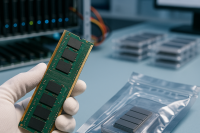AI Demand Sparks Memory Crisis: DRAM, NAND Prices Surge
Published Nov 11, 2025
The memory chip market is in sharp imbalance as surging AI infrastructure demand drives prioritization of HBM and DDR5, constraining legacy DRAM and NAND supply and pushing prices sharply higher. Contract prices rose up to 20% in Q4 2025 (with DRAM spikes as high as 30% reported); hyperscalers receive roughly 70% of their DRAM orders while smaller OEMs see 35–40% fulfillment, forcing heavy spot-market reliance. DDR4 has unexpectedly become a premium asset as manufacturers delay phase-outs, and suppliers are redirecting capacity to HBM, sold out through 2025. Resulting margin gains for major vendors, inflationary pressure across hardware, and structural lead times mean elevated prices and shortages are likely to persist into 2026, making long-term contracts and strategic procurement critical.
Defense Sparks AI Shift: $1.3B, Disinformation Warnings, Regulatory Push
Published Nov 11, 2025
U.S. national security concerns have rapidly reframed AI policy and investment: the Department of Defense’s FY2026 budget proposes $1.3 billion for “AI readiness,” funding autonomous systems, predictive tools, and counter‐adversarial capabilities, while CISA warns of escalating AI‐driven disinformation and state‐backed deepfakes. Congress is coalescing around defense‐focused AI regulations, and state laws like California’s SB 53 add disclosure mandates. Expect accelerated defense R&D and demand for dual‐use capabilities, plus stricter export, access, and provenance controls and heavier compliance burdens for industry. National security has become the decisive catalyst shaping AI development, regulation, and public‐private tensions.
Amazon vs Perplexity: Defining Legal Boundaries for Agentic AI
Published Nov 11, 2025
Amazon has sued Perplexity AI over its Comet browser agent, alleging it logged into customer accounts, impersonated human browsers, violated terms of service, and posed security and privacy harms—potentially breaching the CFAA. Perplexity says Comet acted on users’ instructions and accuses Amazon of protecting its revenue model. The dispute crystallizes tensions between platform control and AI-driven innovation, likely prompting disclosure rules for agents, tighter identity and credential governance, and limits on autonomous transactions. With state laws emerging and federal guidance incomplete, the case could set legal precedent treating agentic AI as liable for unauthorized access and reshape product design, contractual terms, and regulatory policy in e-commerce. Businesses, legal teams, and policymakers should monitor the outcome closely.
California's SB 53: Landmark Transparency Law Reshapes Frontier AI Regulation
Published Nov 11, 2025
California’s SB 53, signed by Gov. Gavin Newsom on Sept. 29, 2025 and effective Jan. 1, 2026, requires AI developers with >US$500M revenue to publish safety protocols, report critical safety incidents to the state within 15 days, and face fines up to US$1M per violation. It defines catastrophic risk (>$1B property damage or >50 deaths/serious injuries), includes whistleblower protections and a public research cloud, and mandates third-party testing tied to deployment standards. As one of the first U.S. state laws to impose concrete reporting deadlines, thresholds, and penalties for frontier models, SB 53 is poised to reshape compliance practices, influence federal policy, and accelerate industry risk-management—while leaving smaller developers outside its scope and raising potential coordination challenges with future federal rules.
Black-Box Reverse-Engineering Exposes LLM Guardrails as Vulnerable Attack Surface
Published Nov 11, 2025
Researchers disclosed a practical Black‐Box Guardrail Reverse‐Engineering Attack (GRA) that, using genetic algorithms and reinforcement learning, infers commercial LLMs’ safety decision policies from input–output behavior. Tested against ChatGPT, DeepSeek and Qwen3, GRA achieved over 0.92 rule‐matching accuracy at under US$85 in API costs, showing guardrails can be cheaply and reliably approximated and evaded. This elevates guardrails themselves into an exploitable attack surface, threatening compliance and safety in regulated domains (health, finance, legal, education) and amplifying risks where retrieval‐augmented or contextual inputs already degrade protections. Mitigations include obfuscating decision surfaces (randomized filtering, honey‐tokens), context‐aware robustness testing, and continuous adversarial auditing. The finding demands urgent redesign of safety architectures and threat models to treat guardrails as resilient, dynamic defenses rather than static filters.
EU Weighs Delaying AI Act Enforcement Amid US Tech Pressure
Published Nov 11, 2025
EU signals a likely easing or delay in the AI Act’s implementation amid lobbying from U.S. tech firms and diplomatic pressure. A draft Digital Omnibus would push enforcement penalties to August 2, 2027, introduce selective pauses, and exempt some high‐risk systems performing narrow or procedural functions from mandatory registration. Industry and U.S. objections cite burdensome transparency and technical standards; EU officials propose “targeted simplification” while asserting commitment to regulation. The shift creates short‐term legal uncertainty—potential competitive advantage for U.S. developers, deferred compliance costs for firms, and risks to EU regulatory credibility and global leadership. A final Digital Omnibus proposal is due November 19, 2025; its scope will determine whether these are timing adjustments or substantive rollbacks.
China Suspends Dual-Use Mineral Export Bans, Relieves Semiconductor Supply Pressure
Published Nov 11, 2025
China’s abrupt suspension (effective 2025-11-09 through 2026-11-27) of export bans on dual‐use materials — notably gallium, germanium, antimony, super‐hard materials and eased controls on graphite, rare earths and lithium‐battery inputs — instantly eases shortages that had roiled semiconductors, photonics, defense and EV supply chains. Framed by a one‐year U.S.–China truce to curb tariffs and freeze retaliatory measures, the move restores market certainty, reduces price volatility and prompts EU talks to stabilize export licensing. However, strategic leverage remains: licenses could be inconsistently granted or reinstated if geopolitics shift. Industries should treat this as temporary relief, accelerate diversification and hedging, and closely monitor licensing implementation and U.S. policy responses to gauge whether supply normalization will endure.
Trump's EO 14179 Rescinds Safety Rules, Prioritizes AI Competitiveness
Published Nov 11, 2025
On Jan. 23, 2025 President Trump issued Executive Order 14179, “Removing Barriers to American Leadership in Artificial Intelligence,” rescinding Biden’s EO 14110 and pivoting federal AI policy from prescriptive safety, equity, and civil‐rights mandates toward economic competitiveness, infrastructure, and national security. Agencies must suspend or revise conflicting rules; OMB must update memoranda M‐24‐10 and M‐24‐18 within 60 days; an AI Action Plan is due in 180 days. The order reduces binding equity/safety requirements, amplifies export control and industry‐growth priorities, and increases tension with state AI laws. Key uncertainties include the undefined notion of “ideological bias,” oversight of dual‐use risks, and potential federal‐state preemption. The content of forthcoming OMB revisions and the AI Action Plan will determine how drastically U.S. policy departs from prior risk‐averse norms.
U.S. Ownership of Intel Signals New State-Backed Semiconductor Era
Published Nov 11, 2025
The U.S. government's acquisition of roughly 9.9% of Intel—backed by $8.9 billion from undisbursed CHIPS Act grants and the Secure Enclave defense program—signals a strategic shift toward an equity-for-subsidy model in semiconductor policy. Though explicitly passive (no board seats), the stake ties public funding to domestic production, security priorities, and tighter “guardrails.” Intel remains central to a $100B-plus buildout within a broader $52B CHIPS framework to re-shore manufacturing and secure defense supply chains. The move creates legal and political friction, sets a precedent for future federal leverage over strategic firms, and alters financing incentives for tech companies. Execution risks—costs, supply chains, yields—and likely legislative scrutiny will determine whether this approach yields durable industrial leadership.
QuantumScape Breakthrough Propels Solid-State Batteries Toward Early Commercialization
Published Nov 11, 2025
Recent breakthroughs in solid- and semi-solid-state batteries are accelerating commercialization. QuantumScape’s QSE‐5 prototype reportedly retains 95% discharge energy after 1,000 cycles, addressing a major cycle‐life barrier. BAK’s semi‐solid “in‐situ solidification” cuts liquid electrolyte below 10%, achieves 300–400 Wh/kg, and shows ≥80% retention after 1,000 EV‐format cycles (≥3,000 cycles at ≥70% for two‐wheelers). Nissan’s dry‐electrode scaling targets ~$75/kWh—about 30% below 2024 pack averages. Complementary electrolyte research (nitrogen‐triggered amorphization) demonstrates 2.02 mS/cm conductivity and ~82% retention after 2,000 cycles. If independently validated and scaled, these advances could enable niche deployment by 2026–2028 and broader adoption around 2030, delivering meaningful improvements in safety, cost, and supply‐chain competitiveness.









